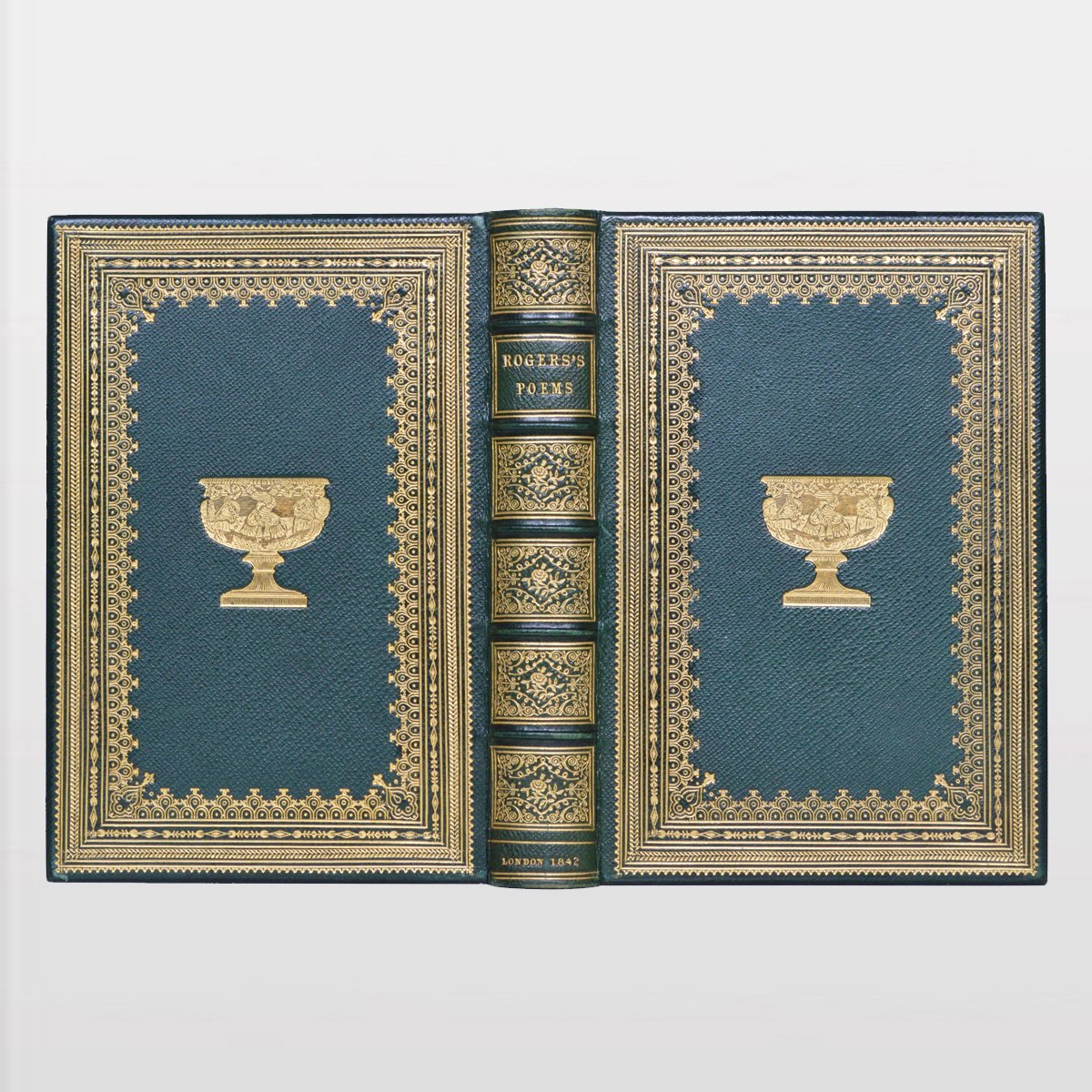Poems. RODGERS (Samuel).
BOUND BY HAYDAY
Engraved frontispiece by Findon after Lawrence, and engraved vignettes after Turner and Stothard.
8vo. [205 x 139 x 32 mm]. viii, 304 pp. Near contemporary binding by Hayday (signed with an ink pallet on front pastedown) of hard-grained green goatskin, the covers tooled in gilt with a wide border of three sets of double fillets and three rolls and at the centre a large block of an ornamental chalice. The spine divided into six panels by raised bands and gilt compartments, lettered in the second and at the foot, the others with a flower surrounded by sprigs and scrolls, the edges of the boards tooled with a gilt broken fillet, the turn-ins with a gilt double fillet and roll, plain endleaves, gilt edges. (Slight hint of rubbing to bands). [ebc7690]
London: [printed by Bradbury and Evans for] Edward Moxon, 1842.
Occasional spotting, quite heavy in places, but the binding remains in almost pristine condition. With ink inscription of front flyleaf: "C. C. Collins - from a sincere friend June 1857". The block on the covers is copied from the engraving on p.118.
James Hayday was apprenticed to a vellum binder, Charles Marchant, later working as a journeyman and then in partnership with Boyer of Poland Street, before renting his own premises in 1833 at 31 Little Queen Street, Lincoln's Inn field. He remained at the same address throughout his binding career, and in the 1840's his shop employed as many as 40 workers including 10 finishers. While much of his output could be perceived as pastiche he had a client in Joseph Walter King Eyton who encouraged him to create some of the most fantastical bindings of the 19th century. He is one of the few binders to have gained an entry in DNB, but he ended up bankrupt in 1861, when he sold the use of his name and retired from the trade.
BOUND BY HAYDAY
Engraved frontispiece by Findon after Lawrence, and engraved vignettes after Turner and Stothard.
8vo. [205 x 139 x 32 mm]. viii, 304 pp. Near contemporary binding by Hayday (signed with an ink pallet on front pastedown) of hard-grained green goatskin, the covers tooled in gilt with a wide border of three sets of double fillets and three rolls and at the centre a large block of an ornamental chalice. The spine divided into six panels by raised bands and gilt compartments, lettered in the second and at the foot, the others with a flower surrounded by sprigs and scrolls, the edges of the boards tooled with a gilt broken fillet, the turn-ins with a gilt double fillet and roll, plain endleaves, gilt edges. (Slight hint of rubbing to bands). [ebc7690]
London: [printed by Bradbury and Evans for] Edward Moxon, 1842.
Occasional spotting, quite heavy in places, but the binding remains in almost pristine condition. With ink inscription of front flyleaf: "C. C. Collins - from a sincere friend June 1857". The block on the covers is copied from the engraving on p.118.
James Hayday was apprenticed to a vellum binder, Charles Marchant, later working as a journeyman and then in partnership with Boyer of Poland Street, before renting his own premises in 1833 at 31 Little Queen Street, Lincoln's Inn field. He remained at the same address throughout his binding career, and in the 1840's his shop employed as many as 40 workers including 10 finishers. While much of his output could be perceived as pastiche he had a client in Joseph Walter King Eyton who encouraged him to create some of the most fantastical bindings of the 19th century. He is one of the few binders to have gained an entry in DNB, but he ended up bankrupt in 1861, when he sold the use of his name and retired from the trade.
BOUND BY HAYDAY
Engraved frontispiece by Findon after Lawrence, and engraved vignettes after Turner and Stothard.
8vo. [205 x 139 x 32 mm]. viii, 304 pp. Near contemporary binding by Hayday (signed with an ink pallet on front pastedown) of hard-grained green goatskin, the covers tooled in gilt with a wide border of three sets of double fillets and three rolls and at the centre a large block of an ornamental chalice. The spine divided into six panels by raised bands and gilt compartments, lettered in the second and at the foot, the others with a flower surrounded by sprigs and scrolls, the edges of the boards tooled with a gilt broken fillet, the turn-ins with a gilt double fillet and roll, plain endleaves, gilt edges. (Slight hint of rubbing to bands). [ebc7690]
London: [printed by Bradbury and Evans for] Edward Moxon, 1842.
Occasional spotting, quite heavy in places, but the binding remains in almost pristine condition. With ink inscription of front flyleaf: "C. C. Collins - from a sincere friend June 1857". The block on the covers is copied from the engraving on p.118.
James Hayday was apprenticed to a vellum binder, Charles Marchant, later working as a journeyman and then in partnership with Boyer of Poland Street, before renting his own premises in 1833 at 31 Little Queen Street, Lincoln's Inn field. He remained at the same address throughout his binding career, and in the 1840's his shop employed as many as 40 workers including 10 finishers. While much of his output could be perceived as pastiche he had a client in Joseph Walter King Eyton who encouraged him to create some of the most fantastical bindings of the 19th century. He is one of the few binders to have gained an entry in DNB, but he ended up bankrupt in 1861, when he sold the use of his name and retired from the trade.

